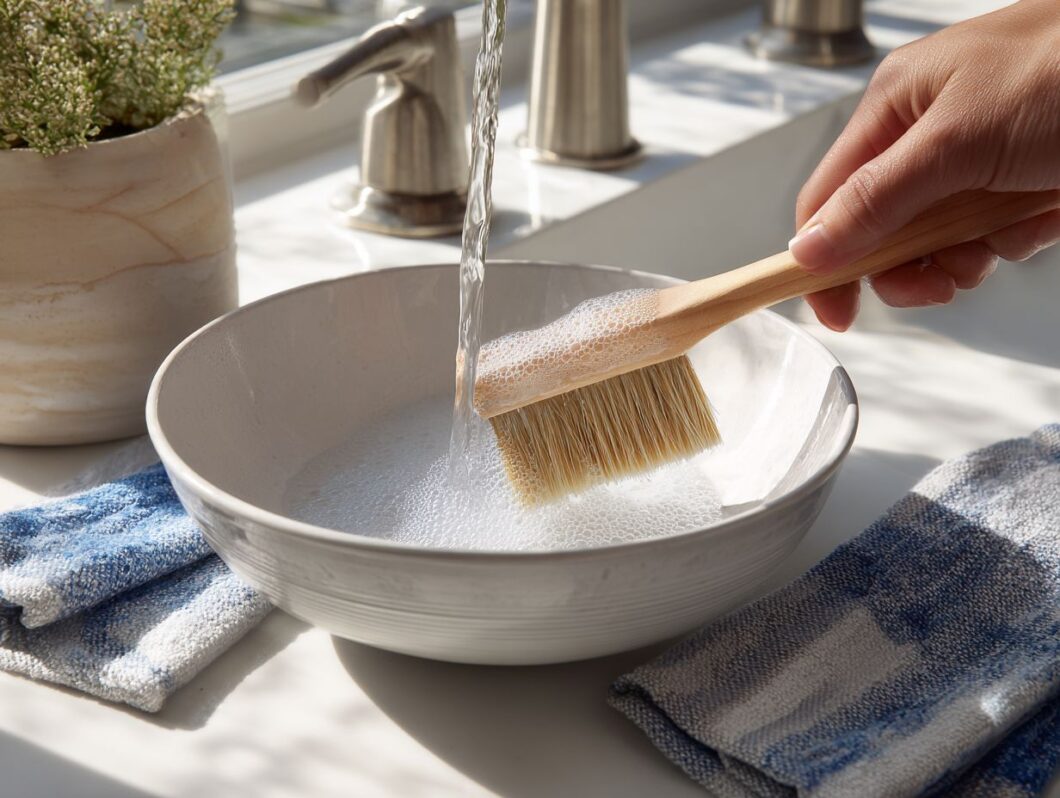The art of brush maintenance is often overlooked, yet it can make all the difference in both performance and longevity. As someone who has struggled with keeping my brushes in pristine condition, I understand the frustration of ruined bristles and bristle damage. In this guide, I’ll share insights on understanding brush materials, essential cleaning tools, and proper cleaning techniques to ensure your brushes remain effective and beautiful. Let’s dive into the secrets of brush care-your artistry deserves it.
Understanding Brush Materials and Bristle Care
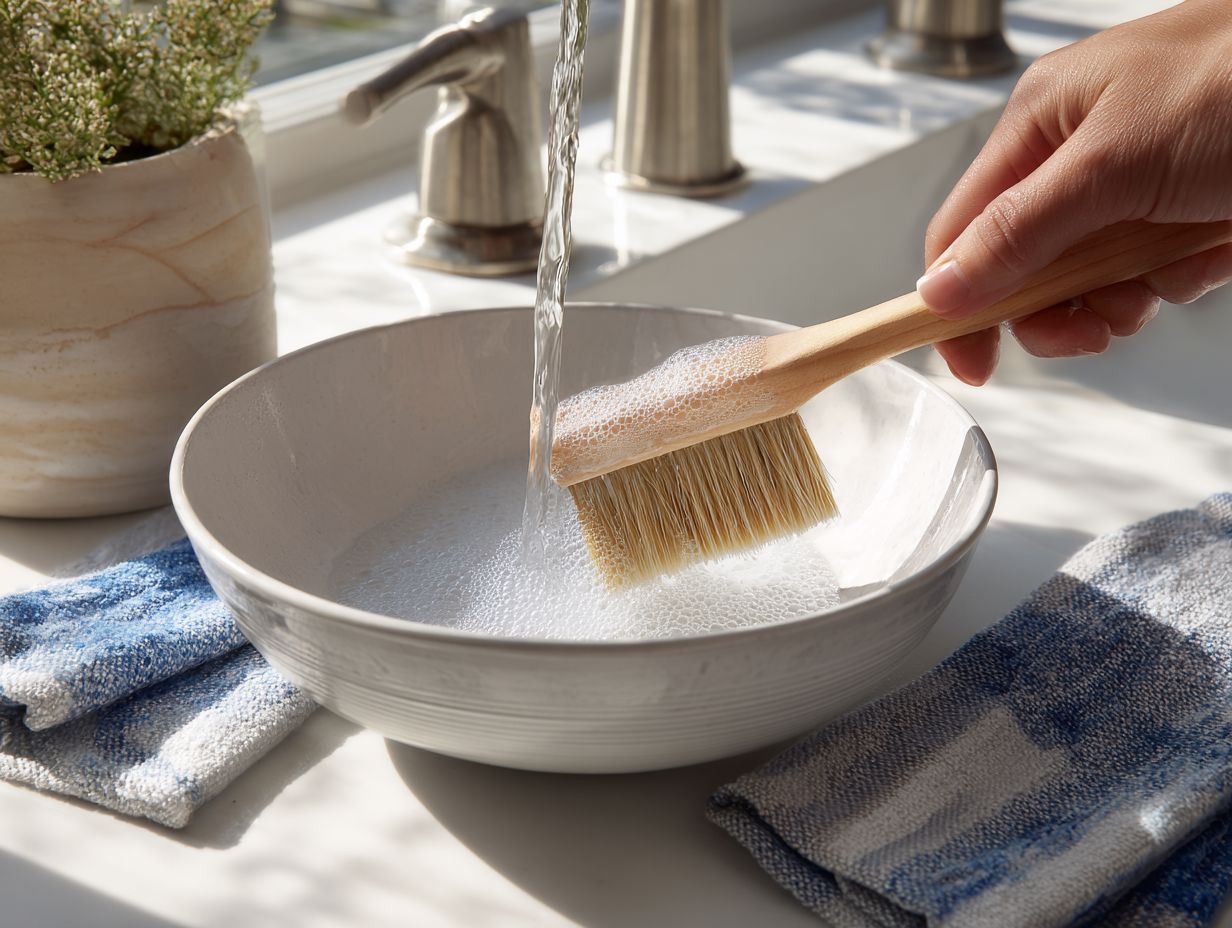
I understand that different brush materials necessitate distinct care methods, which directly influence both the appropriate cleaning techniques and the overall longevity of the brushes.
Synthetic vs. Natural Bristles: Choosing the Right Brush Type
I find that synthetic brushes are generally easier to clean compared to natural hair brushes, which require more delicate care to preserve their shape and integrity.
For natural brushes, I opt for a gentle cleaning solution, such as baby shampoo or specialized brush cleansers, and I ensure to avoid soaking them completely, as this can lead to shedding of the hair. I rinse the brushes under lukewarm water and reshape the bristles before laying them flat to dry.
With proper care, I can expect natural brushes to last between 5 to 10 years, while synthetic brushes may need replacement every 2 to 3 years due to wear and tear.
To further extend the lifespan and maintain the performance of my brushes, I make a point to rotate them regularly.
Choosing the Right Brush for Your Needs
Selecting the right brush for my application significantly enhances both my ease of use and the final outcome, making informed choices essential.
For makeup applications, I prefer using a flat foundation brush, such as the Sigma F60, as it provides a smooth finish with liquid foundations.
When I aim for a more natural look with cream products, I opt for a beauty sponge like the Beautyblender. In the realm of painting, I find that a synthetic filbert brush from Princeton is excellent for blending and works particularly well with acrylics.
For fine art projects, the Escoda Versatil offers excellent versatility for both watercolors and oils.
I recognize that each brush type and brand is specifically designed for particular mediums, which ensures that I achieve optimal results tailored to my needs.
Essential Cleaning Tools for Brush Sanitization
Having the appropriate cleaning tools readily available significantly enhances the efficiency and effectiveness of the brush cleaning process.
Brush Cleaners, Soaps, and Cleaning Agents
I find that using specialized brush cleaners such as Cinema Secrets ($24 for 8 oz) or Beautyblender Liquid Blendercleanser ($16 for 5 oz) can significantly enhance my cleaning results. I recommend incorporating these excellent options into your routine:
- MAC Brush Cleanser ($16 for 7.9 oz) is ideal for quick cleanings and is effective on both synthetic and natural brushes.
- For a deeper clean, I suggest the Sephora Collection Daily Brush Cleaner ($14 for 8 oz), which effectively removes all makeup residue.
Each of these cleaners offers unique advantages; for instance, Cinema Secrets is well-known for its pleasant scent and speed, while Beautyblender’s formula is gentle yet thorough. Regular use of these products can prolong the life of my brushes and improve makeup application, making them worthwhile investments for anyone passionate about beauty.
Alternative Cleaning Solutions
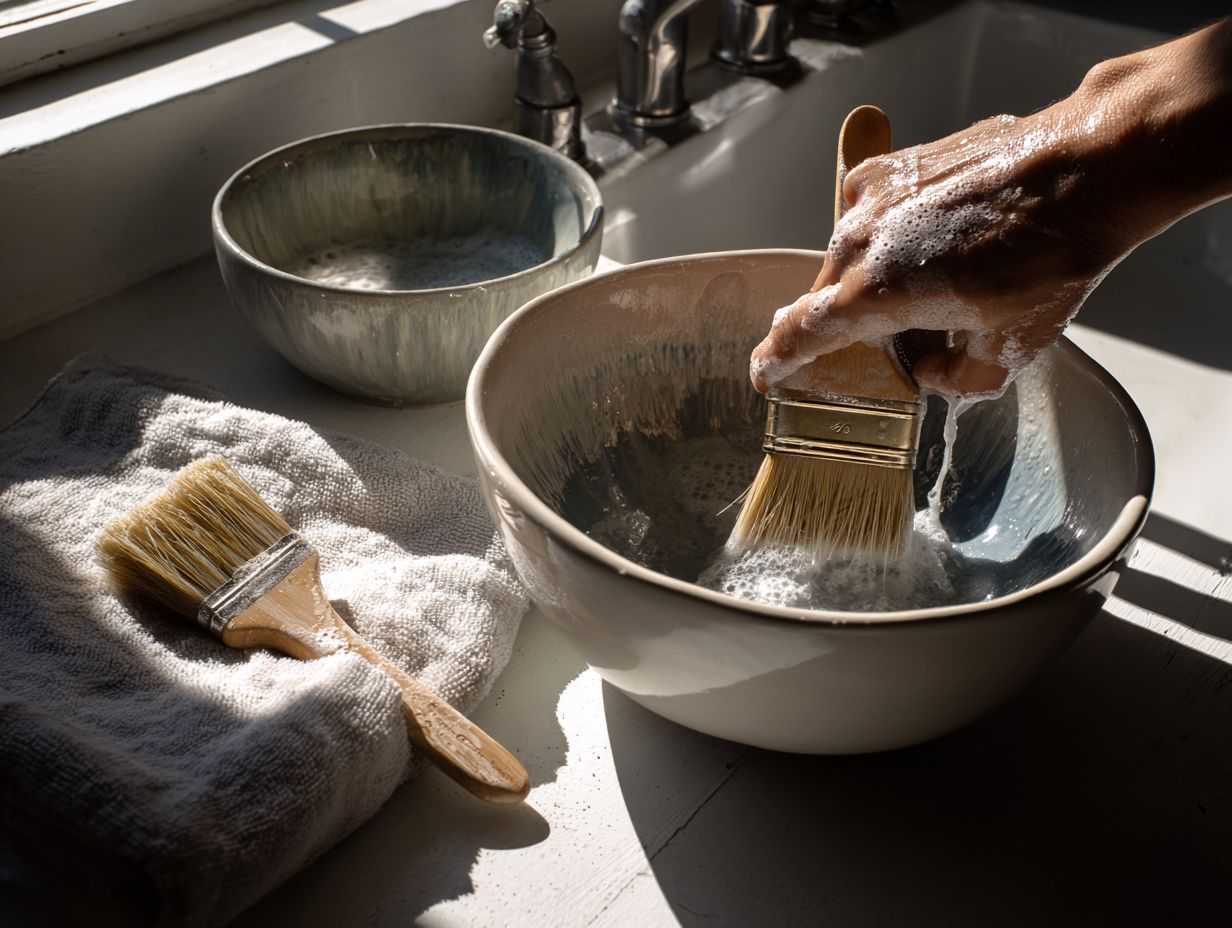
For those of us seeking to avoid chemical cleaners, I have found that eco-friendly cleaning methods such as baby shampoo and olive oil can effectively clean brushes without compromising the integrity of the bristles.
Professional makeup artists frequently endorse these methods for their gentle yet effective cleaning properties.
Baby shampoo, typically priced around $5, is particularly praised for its ability to break down makeup residues while remaining safe for sensitive bristles. Olive oil, which generally costs about $8, serves as another excellent option; its natural lubricating properties help maintain the quality of the brush fibers.
Many artists have shared their success stories with these methods, highlighting cleaner brushes and improved longevity without the harsh effects often associated with traditional cleaners.
Step-by-Step Cleaning Process and Brush Care Tips
I implement a systematic cleaning process to ensure that my brushes are properly cared for, which enhances both their longevity and performance.
Pre-Cleaning Preparations and Cleaning Workflow
Before I begin the cleaning process, I gather my tools: a clean bowl, brush soap, and a microfiber cloth. This preparation helps streamline the task.
I then fill the bowl with lukewarm water and add a small amount of brush soap. Dipping the bristles of each brush into the mixture, I swirl gently to dislodge any makeup residue.
Next, I rinse the brushes under running water, making sure to keep the ferrule dry to avoid loosening the glue. After rinsing, I reshape the bristles and lay the brushes flat on the microfiber cloth to dry.
I aim to clean my makeup brushes on a weekly basis to prevent bacteria buildup and maintain their optimal performance. This entire process typically takes about 10-15 minutes, ensuring my tools remain in excellent condition.
Cleaning Techniques for Different Brushes
Different types of brushes require tailored cleaning approaches to maintain their integrity and functionality. For effective cleaning, I have found the following methods to be quite effective:
- For makeup brushes, I swirl them in a mixture of gentle soap and water for about five minutes, then rinse until the water runs clear.
- Regarding paintbrushes, I wash them with warm, soapy water and reshape the bristles afterward; this process typically takes around five to ten minutes.
- Delicate art brushes, especially those with natural hairs, necessitate hand washing with mild soap. I ensure a gentle touch to preserve their shape.
I recommend allocating about ten to fifteen minutes for the proper cleaning of these brushes to enhance their longevity.
Drying and Storing Your Brushes for Longevity
I understand that employing proper drying techniques and brush storage solutions is essential for preserving the shape and longevity of my brushes.
Proper Drying Techniques and Maintenance Products
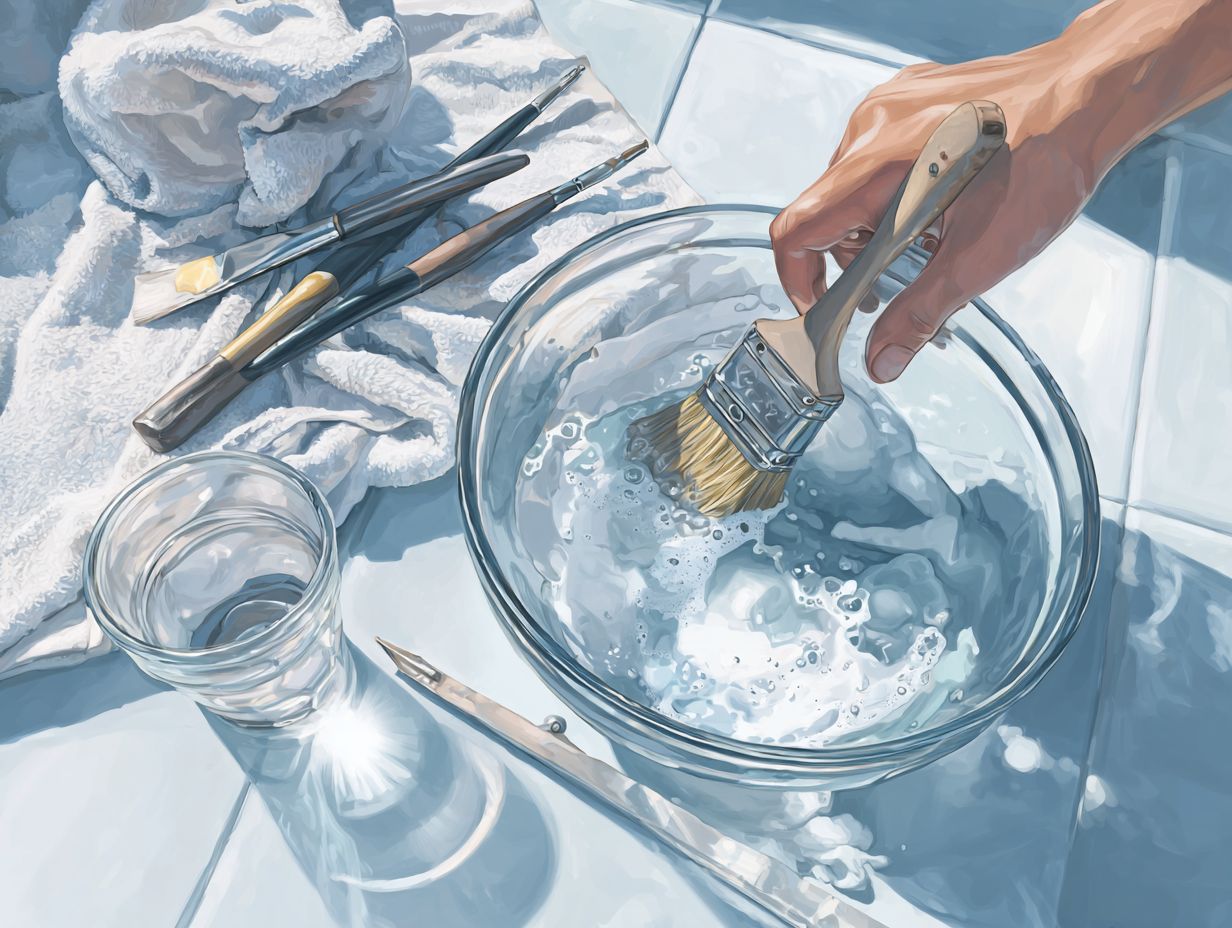
I recommend air drying brushes flat on a clean towel, allowing the bristles to hang off the edge. This method effectively prevents water from seeping into the ferrule. By doing this, I ensure proper airflow, which promotes even drying and helps maintain the brushes’ shape.
It is crucial to avoid standing brushes upright, as this can lead to bristle deformation. After laying them flat, I typically allow them to dry for 4-6 hours, depending on the humidity levels. I also find that placing the brushes in a well-ventilated area can expedite the drying process.
For optimal maintenance, I consider using a brush cleaning solution before drying. This approach helps remove any residue and keeps my brushes in prime condition.
Storage Solutions to Maintain Shape
Investing in a brush holder or case is essential for keeping my brushes organized and maintaining their shape over time. Cylindrical holders, typically priced between $10 and $30, are particularly effective for keeping brushes upright and preventing bristle damage.
Alternatively, I find that brush rolls offer excellent portable storage solutions, ranging from $15 to $40, which are ideal for artists who are frequently on the go. For those seeking a more durable option, a hard case priced around $25 provides additional protection.
Each of these storage options significantly extends the life of my brushes by preventing bending and breakage, ensuring that I maximize the value of my investments.
Common Mistakes to Avoid in Brush Maintenance
I understand that avoiding common brush cleaning mistakes can greatly improve the health and performance of my brushes.
Using Harsh Chemicals
Using harsh chemicals can strip the bristles of their natural oils, ultimately leading to degradation and a loss of functionality over time. To preserve my brushes, I prefer to use gentle alternatives, such as a mixture of mild dish soap and warm water.
For instance, just a few drops of Castile soap in water can effectively cleanse the brushes without causing damage to the bristles.
I make a point to avoid ingredients like alcohol and bleach, as these can be harmful to both synthetic and natural brushes. Instead, I consider using a brush cleaner specifically designed for artists, which typically contains safe solvents that help maintain bristle integrity.
By regularly cleaning my brushes with these methods, I can extend their lifespan and ensure optimal performance in my artistic endeavors.
Improper Drying Methods and Their Impact on Brush Health
Improper drying methods, such as placing brushes upright, can result in water damage and bristle deformation, ultimately compromising their performance. To keep my brushes in optimal condition, I lay them flat on a clean, dry towel. This approach prevents moisture from accumulating in the ferrule, where the bristles are attached.
After the brushes are dry, I gently reshape the bristles with my fingers to maintain their original form. I make it a point to avoid twisting or pulling on the bristles, as this can lead to breakage.
I also consider using a brush holder that promotes airflow while preventing the bristles from flattening. By incorporating these regular maintenance practices, I can significantly extend both the life and effectiveness of my brushes.
Frequently Asked Questions
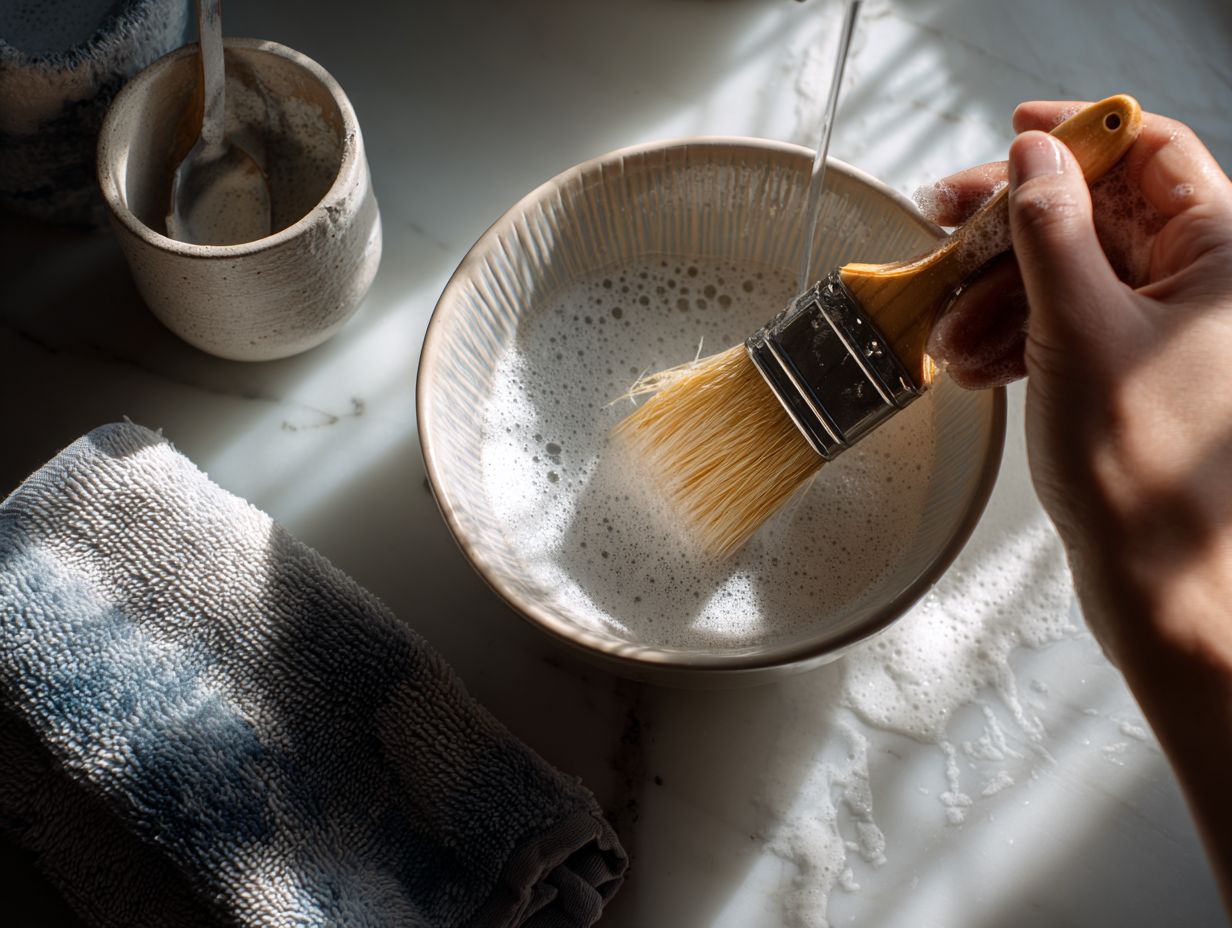
How can I keep my brushes clean without ruining them?
One way to keep your brushes clean without damaging them is to rinse them with warm water temperature after each use. This will help with residue removal of any excess product and prevent buildup and enhance brush hygiene.
What cleaning products should I use to clean my brushes?
You can use a mild detergent or shampoo to clean your brushes. Avoid oil-based cleaners or chemicals as they can be damaging to the firm bristles and affect brush quality.
How often should I follow my cleaning routine for my brushes?
Ideally, you should clean your brushes after each use. This cleaning frequency will help prevent product buildup and bacteria, ensuring that your brushes stay in good condition for longer and maintain brush longevity.
Is it necessary to use a brush cleaning systems cleanser?
No, you don’t necessarily need a specific brush cleanser to clean your brushes. A mild soap or shampoo can work just as well, as long as you follow proper rinsing and dry your brushes afterwards to maintain brush appearance.
Can I use alcohol or cleaning spray to clean my brushes?
No, it is not recommended to use alcohol to clean your brushes. It can be too harsh and damaging to the bristles, affecting brush functionality and may also cause them to dry out and become brittle over time.
How should I dry my brushes after following cleaning instructions?
After cleaning your brushes, gently reshape the bristles and lay them flat on a clean towel or cleaning cloth to dry. Avoid standing them upright as this can cause water to seep into the brush handle and loosen the bristles. Make sure they are completely dry before using them again to ensure brush preservation.


